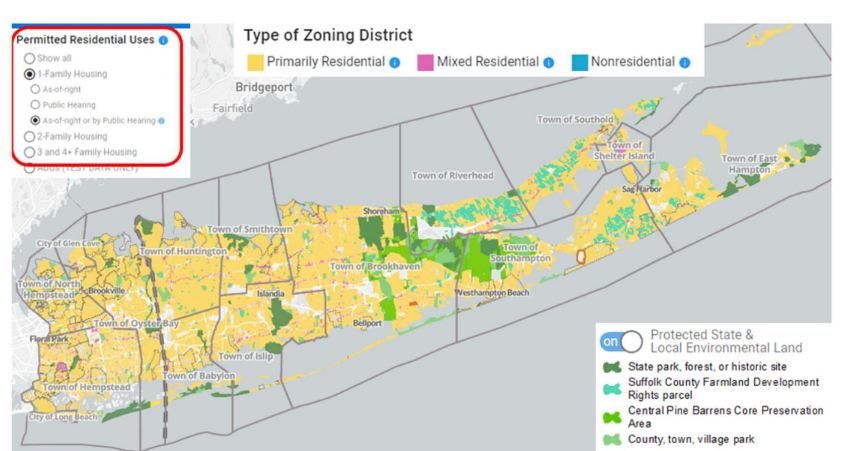A group of nonprofits has launched the Long Island Zoning Atlas, an online platform aimed at offering insights into zoning patterns to help identify housing development opportunities in Nassau and Suffolk counties.
Created in partnership with the Community Development Long Island (CDLI), the Rauch Foundation, the Long Island Community Foundation, and the City University of New York (CUNY) Graduate Center, the new online platform provides a comprehensive mapping of all zoning districts, offering detailed information on the types of housing permitted in each area and other characteristics.
The atlas is modeled after the National Zoning Atlas and a regional atlas that was previously created in Connecticut. The Long Island version was developed with initial data collected by the Regional Plan Association and CDLI and involved gathering over 100 attributes for each of the 1,200 zoning districts across Long Island’s 100-plus municipalities.
“The need for more home options–single-family, accessory dwelling units, townhomes and multifamily developments on Long Island is real and urgent, but too often decision-makers simply don’t have the tools they need to take the next step,” Gwen O’Shea, president and CEO of CDLI, said in a joint statement. “The Long Island Zoning Atlas provides the data that we need to expertly inform these discussions because the solutions are not one-size-fits-all. Stakeholders will now have a real-time understanding of what is possible.”
The zoning atlas connects the attributes of each zoning district to the digital map boundaries of each district. It also delineates other area-specific elements such as protected environmental areas and special service districts, incorporating data from the Long Island Index project created by the Rauch Foundation.
“The Rauch Foundation learned the power of ‘seeing is believing’ when we built the Long Island Index interactive maps. At a glance, one can see the complex interplay between geographical location, political structures, demographic trends, and more,” Nancy Rauch Douzinas, board chair of the Rauch Foundation, said in the statement. “The Long Island Zoning Atlas continues in that rich tradition. Long Island’s need for more multifamily housing is well documented. The atlas makes it clear how we have zoned ourselves into a situation where meeting that need is so much more difficult than it should be. I look forward to these maps being used to clarify and inform residents and elected officials about how and where we can do more to meet this urgent need.”
The atlas is primarily aimed at stakeholders involved in housing development on Long Island, providing a regional view of housing opportunities controlled by local zoning, such as how much of Long Island allows single-family homes as-of-right compared to multifamily housing. The map shows developers where zoning regulations are open to multifamily development and where exclusionary zoning practices exist.
Steven Romalewski, mapping service director at the CUNY Graduate Center for Urban Research, said that in Long Island’s districts that are zoned primarily residential, single-family homes can be built almost everywhere – on 99.5% of these districts – without a public hearing.
“We also discovered that only 8.5% of districts allow two-family homes, and even fewer, just 3.6%, permit three-family and four or more-family housing,” he said in the statement. “We hope all Long Islanders will benefit from this critical information now at their fingertips.”
The project was completed with funding from the Association for a Better Long Island, Bank United, CDLI, Long Island Association, Long Island Builders Institute, the Long Island Community Foundation, the Mercatus Center, Nassau County Industrial Development Agency, Rauch Foundation, Suffolk County Economic Development Corporation and in collaboration with The Center for Urban Research.
The atlas can be found at: longislandzoningatlas.org
Image and article originally from libn.com. Read the original article here.

